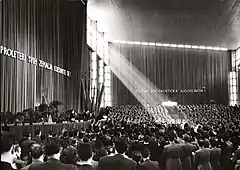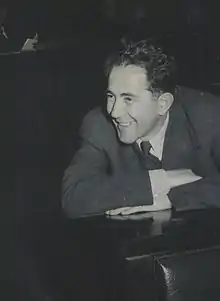6th Congress of the Communist Party of Yugoslavia
The Communist Party of Yugoslavia held its sixth congress in Zagreb on 2–7 November 1952. It was attended by 2,022 delegates representing 779,382 party members. The sixth congress sought to discuss new policies, first of all in reaction to the Yugoslav–Soviet split and Yugoslav rapprochement with the United States. The congress is considered the peak of liberalisation of Yugoslav political life in the 1950s. The congress also renamed the party the League of Communists of Yugoslavia.
 Deputies meeting at the sixth congress of the Communist Party of Yugoslavia. | |
| Date | November 2–7, 1952 |
|---|---|
| Location | Zagreb, FNR Yugoslavia |
| Type | political convention |
| Organised by | Communist Party of Yugoslavia |
New policies were adopted, while old policies were put on the shelf. However, some of the sixth congress' adopted resolutions were reversed when relations with the Soviet Union were normalised. The congress approved workers' self-management and discussed the nature of Yugoslav federalism. Principal authors of documents adopted by the congress were Edvard Kardelj and Milovan Đilas. The latter thought that the liberalisation policies should be reinforced and extended. This brought him in conflict with Josip Broz Tito, the General Secretary of the party's Central Committee, resulting in the removal of Đilas from leading positions in state and party.
Background

The Communist Party of Yugoslavia (Komunistička partija Jugoslavije, KPJ) was a political party established in the Kingdom of Yugoslavia in 1919. By the end of the next year it was banned and forced to function covertly and abroad.[1] Following Invasion of Yugoslavia by the Axis powers in 1941, it organised and led Partisan resistance,[2] The resistance grew increasingly successful and received recognition from the Allies. Following a 1944 power-sharing agreement concluded with the Yugoslav government-in-exile, the KPJ led the formation of the Provisional Government of the Democratic Federal Yugoslavia in March 1945.[3] Later that year, the KPJ won the 1945 Yugoslavian parliamentary election boycotted by its opposition.[4] By 1947, the KPJ moved to suppress any political opposition.[5]
In 1948, the Yugoslav–Soviet split over a range of foreign-policy issues became public.[6] The fifth congress of the KPJ, in reaction to the split, reaffirmed its support for Josip Broz Tito's leadership, and he was reelected at 1st Plenary Session of the Central Committee. Nonetheless, the fifth congress reaffirmed its opposition to the capitalism of the Western Bloc. In the immediate aftermath of the fifth congress of the KPJ, Yugoslav relations with the West deteriorated, particularly burdened by the dispute over the Free Territory of Trieste. As a result, it is said that the KPJ adopted a very rigid position towards the Soviet Union and its leader Joseph Stalin.[7] Hilde Katrine Haug has described the Yugoslav position as more Stalinist than the one held by Stalin.[8]
Yugoslavia was compelled to ask the United States for economic assistance in the summer of 1948 due to the closure of foreign trade with the countries of the Eastern Bloc.[9] The United States Government cautiously approved the request, wishing to score a Cold War victory over the Soviet Union.[10] By 1949–50 the scope of American aid increased to encompass loans and large grants.[11] By 1951, faced with the prospect of a Soviet invasion, Yugoslavia joined the Mutual Defense Assistance Program, and began receiving US military aid as well.[12]
Given the circumstances and the ideological aspect of the Yugoslav–Soviet split, the KPJ found it necessary to differentiate the Yugoslav political system from the Soviet one. Since the KPJ labelled the USSR undemocratic, it was necessary to devise a new communist approach to governing.[13] By introducing workers' self-management, by questioning the former insistence on the unitary state and criticising what it considered the dangerous manifestations of Stalinism a unique communist project was conceived.[14] The approach led to a period of ideological flexibility where even longstanding party dogmas were questioned.[15] Nonetheless, even though the self-management policy gave state-owned enterprises and their municipal-level KPJ patrons the freedom to decide on enterprise-level economic matters, funding of those enterprises remained highly-centralised.[16]
Decisions

The sixth congress of the KPJ convened on 2–7 November 1952 in Zagreb. It was attended by 2,022 delegates representing 779,382 KPJ members.[17] The main venue was the then site of the Zagreb Fair, specifically the building which later became home of the Nikola Tesla Technical Museum.[18] At the congress, the leadership declared its intention to change the party's role in society. The intention was to change the party role from director to educator by influencing communists and everyday political and societal life. Another proposal that was approved was to reduce the central role played by the state bureaucracy.[13] That would leave the central party apparatus to pursue the development of policies and ideology, and act primarily through persuasion.[19] The congress also endorsed the policy of workers’ self-management.[20]
To make the change more apparent, the KPJ changed its name. At the congress, Tito proposed to change the party name to "League of Communists of Yugoslavia" (Savez komunista Jugoslavije, SKJ). The name was inspired by the Communist League, an organization that existed 1847–1852 of which the likes of Karl Marx, Friedrich Engels, and Karl Schapper were activists.[21] Similarly, the Politburo's name was changed to "Executive Committee".[22]
The congress adopted two resolutions – on the role of the SKJ and submitted by the Central Committee and its Central Auditing Commission. It re-elected Tito as the General Secretary of the SKJ. It elected 109 individuals to the Central Committee and 13 individuals to the Executive Committee.[23] Besides Tito, the Executive Committee consisted of Edvard Kardelj, Milovan Đilas, Aleksandar Ranković, Boris Kidrič, Moša Pijade, Ivan Gošnjak, Svetozar Vukmanović, Đuro Salaj, Đuro Pucar, Lazar Koliševski, Franc Leskošek, and Vladimir Bakarić.[24] Kardelj and Đilas were the principal authors of the documents adopted at the congress.[25]
The sixth congress was the high point of liberalisation in Yugoslavia in 1950s. The party Charter was amended at the congress as well, with decentralisation and socialist democracy reemphasized. The sixth congress also signalled a decline in critical discourse. However, the consensus reached the sixth congress' would prove to be short-lived, and an ideological conflict would soon take place.[26]
Aftermath

Within a year of the congress, there were complaints of improper implementation of adopted congress policies. Lower-ranking party officials continued to accept instructions from superior levels without exchanges of opinions. In other instances, party organisations interpreted the policy as a call for passivity and an opportunity to work less. Also, there were examples where lower-level party bodies interpreted the new policies as giving them the option of ignoring instructions from above, avoiding meetings, or performing their financial obligations.[27] The change of policy also spurred a debate on the Yugoslav federal system – the role of constituent republics and status of various peoples in Yugoslavia. While comparably minor in importance at the time, the issues would be revisited in the late 1960s and early 1970s and lead to the adoption of a new Yugoslav constitution.[26]
In 1953, Tito and Ranković organised the second plenary session of the central committee at the Brijuni Islands. There, they instituted new rules virtually reversing many elements of the policy adopted at the sixth congress. The move was at least in part a result of Stalin’s death earlier that year and Tito’s assumption that such course of action would reduce the Soviet.[26]
Đilas, on the other hand, held that the resolutions of the sixth congress did not go sufficiently far.[26] He wrote a series of articles for publication in the party newspaper Borba effectively advocating the introduction of a multi-party system. The party leadership reacted by expelling him in January 1954. The removal of Đilas was interpreted as a prerequisite for improvement of relations with the USSR. Months later, the Yugoslav leadership commended Stalin’s immediate successor Georgy Malenkov. In May 1955, when Nikita Khrushchev and Nikolai Bulganin visited Belgrade, Yugoslavia and the USSR agreed to rebuild their relations on new grounds.[28]
Tito found out that he could maximise his negotiating power by keeping Yugoslavia neutral in the Cold War between the United States and the Soviet Union.[26] Therefore, regardless of the rapprochement with the Soviets, Yugoslavs informed the United States their policy towards the West would remain unchanged. In turn, the American officials were confident that Yugoslavia would not become allied with the Soviet Union.[29]
Footnotes
- Banac 1988, pp. 46–51.
- Tomasevich 2001, p. 88.
- Roberts 1973, pp. 316–317.
- Flere & Klanjšek 2019, pp. 59–60.
- Flere & Klanjšek 2019, pp. 61–62.
- Ramet 2006, pp. 175–176.
- Banac 1988, pp. 137–138.
- Haug 2012, p. 134.
- Banac 1988, p. 131.
- Lees 1978, pp. 410–412.
- Brands 1987, p. 41.
- Brands 1987, pp. 46–47.
- Haug 2012, p. 138.
- Haug 2012, p. 137.
- Banac 1988, p. 139.
- Rusinow 2007, p. 133.
- Jandrić 1982, p. 133.
- Korov 2013, p. 67.
- Banac 1988, p. 141.
- Haug 2012, pp. 140–141.
- Štefančić 2007, p. 264.
- Štefančić 2007, pp. 266–267.
- Jandrić 1982, p. 135.
- Štefančić 2007, p. 266.
- Haug 2012, p. 140.
- Haug 2012, p. 139.
- Lilly 2001, pp. 221–222.
- Banac 1988, pp. 141–142.
- Lees 1997, pp. 135–136.
References
- Banac, Ivo (1988). With Stalin against Tito: Cominformist Splits in Yugoslav Communism. Ithaca, New York: Cornell University Press. ISBN 0-8014-2186-1.CS1 maint: ref=harv (link)
- Brands, Henry W. Jr (1987). "Redefining the Cold War: American Policy toward Yugoslavia, 1948–60". Diplomatic History. Oxford University Press. 11 (1): 41–53. doi:10.1111/j.1467-7709.1987.tb00003.x. ISSN 0145-2096. JSTOR 24911740.CS1 maint: ref=harv (link)
- Flere, Sergej; Klanjšek, Rudi (2019). The Rise and Fall of Socialist Yugoslavia: Elite Nationalism and the Collapse of a Federation. Lanham, Maryland: Rowman & Littlefield. ISBN 9781498541978.
- Haug, Hilde Katrine (2012). Creating a Socialist Yugoslavia: Tito, Communist Leadership and the National Question. London, UK: Bloomsbury Publishing. ISBN 9780857721211.
- Jandrić, Berislav (1982). "Izvori i literatura za povijest Komunističke partije Hrvatske – Saveza komunista Hrvatske 1945–1978" [Sources and Literature for the History of the Communist Party of Croatia – League of Communsts of Croatia 1945–1978]. Journal of Contemporary History (in Croatian). Zagreb, Croatia: Croatian Institute of History. 14 (2): 129–178. ISSN 0590-9597.
- Korov, Goran (2013). "Pogled na prve godine socijalizma u Hrvatskoj" [A View of the First Years of Socialism in Croatia]. Kvartal : kronika povijesti umjetnosti u Hrvatskoj (in Croatian). Zagreb, Croatia: Art History Institute. 10 (1–2). ISSN 1334-8671.
- Lees, Lorraine M. (1978). "The American Decision to Assist Tito, 1948–1949". Diplomatic History. Oxford University Press. 2 (4): 407–422. doi:10.1111/j.1467-7709.1978.tb00445.x. ISSN 0145-2096. JSTOR 24910127.CS1 maint: ref=harv (link)
- Lees, Lorraine M. (1997). Keeping Tito Afloat: The United States, Yugoslavia, and the Cold War, 1945-1960. University Park, Pennsylvania: Penn State University Press. ISBN 9780271040639.
- Lilly, Carol S. (2001). Power And Persuasion: Ideology And Rhetoric In Communist Yugoslavia, 1944-1953. Boulder, Colorado: Westview Press. ISBN 0-8133-3825-5.
- Ramet, Sabrina P. (2006). The Three Yugoslavias: State-building and Legitimation, 1918-2005. Bloomington, Indiana: Indiana University Press. ISBN 9780253346568.CS1 maint: ref=harv (link)
- Roberts, Walter R. (1973). Tito, Mihailović, and the Allies, 1941-1945. New Brunswick, New Jersey: Rutgers University Press. ISBN 978-0-8135-0740-8.
- Rusinow, Dennison (2007). "Reopening of the "National Question" in the 1960s". In Cohen, Lenard J.; Dragović-Soso, Jasna (eds.). State Collapse in South-Eastern Europe: New Perspectives on Yugoslavia's Disintegration. West Lafayette, Indiana: Purdue University Press. pp. 131–148. ISBN 978-1-55753-461-3.
- Štefančić, Domagoj (2007). "Promjena naziva Komunističke partije Jugoslavije u Savez komunista Jugoslavije" [The Change of Name from the Yugoslav Communist Party to the League of Communists of Yugoslavia]. Journal of the Institute of Croatian History (in Croatian). Zagreb, Croatia: Faculty of Philosophy Zagreb, FF press. 39 (1): 259–273.
- Tomasevich, Jozo (2001). War and Revolution in Yugoslavia, 1941–1945: Occupation and Collaboration. Stanford, California: Stanford University Press. ISBN 978-0-8047-0857-9.
